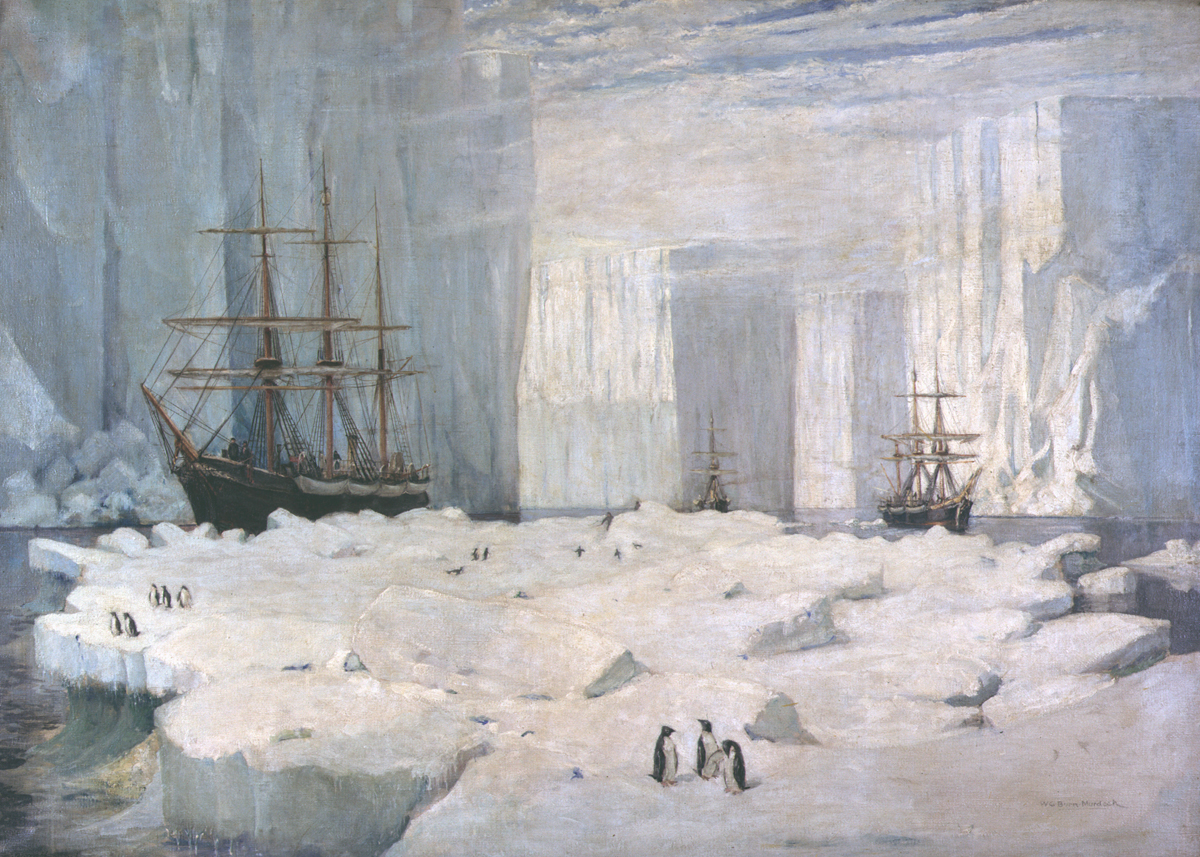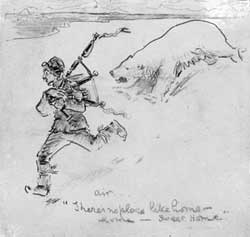William Gordon Burn-Murdoch on:
[Wikipedia]
[Google]
[Amazon]
William Gordon Burn Murdoch (22 January 1862 – 19 July 1939) was a Scottish painter, travel writer and explorer. Murdoch travelled widely including India and both the Arctic and the Antarctic. He is said to be the first person to have played the bagpipes in the Antarctic. He published several travel books as well as being an accomplished artist. A cape in the South Orkneys is named in his honour.

 Burn Murdoch's first major expedition was in 1892 when he joined an investigative whaling expedition to the
Burn Murdoch's first major expedition was in 1892 when he joined an investigative whaling expedition to the
Geoff Swinney, National Museums Scotland, retrieved 3 December 2013 Burn Murdoch had mixed feelings about the trip. The expedition had been to the Falkland Islands and
Glasgow Digital Library, retrieved 3 December 2013 Burn Murdoch continued his friendship with William Spiers Bruce, whom he had first met at university. He helped him by lending him money and later with organising a number of projects including the
scottish-places.info, retrieved 3 December 2013 The two of them were later involved with a company that intended to commercially exploit the island of
Life
Burn Murdoch was born inEdinburgh
Edinburgh ( ; gd, Dùn Èideann ) is the capital city of Scotland and one of its 32 Council areas of Scotland, council areas. Historically part of the county of Midlothian (interchangeably Edinburghshire before 1921), it is located in Lothian ...
to Jessie Cecilia (née Mack) and Dr. William Burn-Murdoch. His father was the first to take the name Burn-Murdoch, but the hyphen was not used by his son. His elder brother, John Burn-Murdoch
John is a common English name and surname:
* John (given name)
* John (surname)
John may also refer to:
New Testament
Works
* Gospel of John, a title often shortened to John
* First Epistle of John, often shortened to 1 John
* Second ...
, joined the military and became the commanding engineer of state railways in India.
He attended a local school and then studied law at Edinburgh University. When he emerged, however, he went to study art in Antwerp and Paris.
Burn Murdoch was closely associated with Patrick Geddes' Fin de Siècle Scottish cultural revival. He and the Symbolist
Symbolism was a late 19th-century art movement of French and Belgian origin in poetry and other arts seeking to represent absolute truths symbolically through language and metaphorical images, mainly as a reaction against naturalism and realis ...
painter John Duncan curated the art content of the Summer Meetings which Geddes organised at University Hall Extension in Edinburgh in the 1880s and '90s. Burn Murdoch contributed illustrations to the Spring, Summer and Winter volumes of ''The Evergreen: A Northern Seasonal'' published by Patrick Geddes and Colleagues between 1895 and 1897. He was also involved in Geddes' plan to create a mural around Castlehill Water Reservoir. He created a banner 1.4 metres long showing prominent figures in Scottish history. The mural was never created but colour and monochrome versions of the ten lithographs making up his design were sold.

 Burn Murdoch's first major expedition was in 1892 when he joined an investigative whaling expedition to the
Burn Murdoch's first major expedition was in 1892 when he joined an investigative whaling expedition to the Antarctic
The Antarctic ( or , American English also or ; commonly ) is a polar region around Earth's South Pole, opposite the Arctic region around the North Pole. The Antarctic comprises the continent of Antarctica, the Kerguelen Plateau and other ...
. He served as an assistant to William Speirs Bruce
William Speirs Bruce (1 August 1867 – 28 October 1921) was a British Natural history, naturalist, polar region, polar scientist and Oceanography, oceanographer who organized and led the Scottish National Antarctic Expedition (SNAE, 1902–04) ...
, a medical student with an interest in oceanography. Burn Murdoch, who was known as "WG" to his friends, used this opportunity to create paintings of their journeys and he had a contract to create a book. With these and his notes he wrote the book ''Edinburgh to the Antarctic'' which was published by Longmans in 1894. It was said that he was the first "Artist in Residence" in the Antarctic.William Gordon Burn MurdochGeoff Swinney, National Museums Scotland, retrieved 3 December 2013 Burn Murdoch had mixed feelings about the trip. The expedition had been to the Falkland Islands and
Ross Island
Ross Island is an island formed by four volcanoes in the Ross Sea near the continent of Antarctica, off the coast of Victoria Land in McMurdo Sound. Ross Island lies within the boundaries of Ross Dependency, an area of Antarctica claimed by New ...
, and had discovered and named Dundee Island, but the scientific role he was expected to help with was undervalued, and both he and Bruce had been obliged to help with killing 5,000 seals which was the expedition's only hope of commercial success as they had failed to find any commercial whales. Despite these setbacks and having his teeth loosened by scurvy he gained a love of polar exploration.Voyage of the BalaenaGlasgow Digital Library, retrieved 3 December 2013 Burn Murdoch continued his friendship with William Spiers Bruce, whom he had first met at university. He helped him by lending him money and later with organising a number of projects including the
Scottish National Antarctic Expedition
The Scottish National Antarctic Expedition (SNAE), 1902–1904, was organised and led by William Speirs Bruce, a natural scientist and former medical student from the University of Edinburgh. Although overshadowed in terms of prestige by Robe ...
in 1902–04. During that expedition Bruce surveyed Laurie Island in the South Orkneys. Cape Burn Murdoch
A cape is a clothing accessory or a sleeveless outer garment which drapes the wearer's back, arms, and chest, and connects at the neck.
History
Capes were common in medieval Europe, especially when combined with a hood in the chaperon. Th ...
on that island is named in his honour.William Gordon Burn Mudochscottish-places.info, retrieved 3 December 2013 The two of them were later involved with a company that intended to commercially exploit the island of
Spitzbergen
Svalbard ( , ), also known as Spitsbergen, or Spitzbergen, is a Norwegian archipelago in the Arctic Ocean. North of mainland Europe, it is about midway between the northern coast of Norway and the North Pole. The islands of the group range ...
.
In 1905 he travelled with the Prince
A prince is a male ruler (ranked below a king, grand prince, and grand duke) or a male member of a monarch's or former monarch's family. ''Prince'' is also a title of nobility (often highest), often hereditary, in some European states. Th ...
and Princess of Wales
Princess of Wales (Welsh: ''Tywysoges Cymru'') is a courtesy title used since the 14th century by the wife of the heir apparent to the English and later British throne. The current title-holder is Catherine (née Middleton).
The title was firs ...
on their visit to India
India, officially the Republic of India (Hindi: ), is a country in South Asia. It is the seventh-largest country by area, the second-most populous country, and the most populous democracy in the world. Bounded by the Indian Ocean on the so ...
, which he used as the basis for a book describing his travels in India and Burma. In 1906 he was made a fellow of the Royal Scottish Geographical Society, and he remained an active member. The society own a collection of his work, including a large oil painting in its board room.
After some commercial whaling he published "Modern whaling and bear hunting" in 1917, which he again illustrated and which described his interest in polar bears. The Royal Scottish Geographical Society has humorous cartoons he created featuring polar bears. One of his polar bear sketches was used as an RSGS Christmas card
A Christmas card is a greeting card sent as part of the traditional celebration of Christmas in order to convey between people a range of sentiments related to Christmastide and the holiday season. Christmas cards are usually exchanged during t ...
. Burn Murdoch also captured polar bears, and gave a young polar bear to the Zoological Society of Scotland
The Royal Zoological Society of Scotland is a learned society and registered charity based in Edinburgh, Scotland. It was founded by Thomas Haining Gillespie in 1909. In 1913, Edinburgh Town Council bought a large plot of land on Corstorphin ...
.
Burn Murdoch died in 1939 in Edinburgh. He and his wife had lived at Arthur Lodge, where they entertained visitors, including Roald Amundsen
Roald Engelbregt Gravning Amundsen (, ; ; 16 July 1872 – ) was a Norwegian explorer of polar regions. He was a key figure of the period known as the Heroic Age of Antarctic Exploration.
Born in Borge, Østfold, Norway, Amundsen bega ...
and Robert Falcon Scott. Burn Murdoch was a keen musician as well as an artist, and he claimed to be the first person to have played the bagpipes in the Antarctic.
Legacy
He is noted for saying that he had been to "From the Arctic and Antarctic to 'the back parts of Mull'". His writings and paintings are in a number of institutions including the Royal Scottish Geographical Society, the Victoria and Albert, and the Perth & Kinross Council and Dundee Museum.References
External links
* * {{DEFAULTSORT:Burn Murdoch, William Gordon 1862 births 1939 deaths Artists from Edinburgh Scottish explorers 19th-century Scottish painters Scottish male painters 20th-century Scottish painters Scottish travel writers Alumni of the University of Edinburgh Explorers of Antarctica 19th-century Scottish male artists 20th-century Scottish male artists